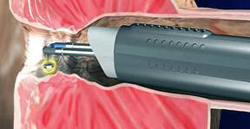
Transurethral vaporization of the prostate (TUVP) utilizes the heat from high-voltage electric current which ablates obstructive prostatic tissue and seals the surrounding blood vessels. The electric current is delivered to the prostate using a loop electrode or a grooved roller electrode (e.g., VaporTrode®), which is attached to a continuous flow resectoscope and connected to a standard electrosurgical unit.
TUVP can be performed under general or regional anesthesia, or sometimes under intravenous sedation with intraurethral xylocaine. The procedure usually takes 35–70 minutes. Prior to treatment, a standard cystourethroscopy is performed to determine the size and intra urethral anatomy of the prostate.
The loop or grooved bar electrode is attached to a continuous flow resectoscope. In electrosurgical vaporization, the VaporTrode rapidly heats the tissue cells so that they essentially turn into steam, thus leaving a space where the obstructing tissue resided. The bulk of the heat is changed into steam and which is washed away via the continuous flow from the resectoscope. As the electrode moves to a new area, more cells are similarly removed thus creating a space and removing the obstructing tissue. Additionally, any larger tissue debris is also washed away by the constant irrigation through the resectoscope.
Because TUVP coagulates and seals blood and lymphatic vessels, blood loss during the procedure is minimized. Results are similar to TURP and open prostatectomy, typically without causing significant postoperative complications. In most cases, the catheter is removed and patients are discharged within 1–3 days.




